96th Evacuation Hospital Unit History

Map illustrating the route of the 96th Evacuation Hospital while operating in the European Theater (drawn by Pfc Don J. Anders in 1945).
Activation & Training
The 96th Evacuation Hospital was activated as a direct result of General Order Number 85, Headquarters Third United States Army on 5 August 1942 as the 8th Surgical Hospital. Shortly after its activation, the unit was redesignated as the 96th Evacuation Hospital following directions received from the Adjutant General’s Office, dated 14 August, 1942. First Lieutenant Alvin F. Bates and 20 EM formed the original cadre drawn from the 6th Surgical Hospital at Fort Knox, Louisville, Kentucky (Armored Replacement Training Center and School –ed). This group arrived at Camp Shelby, Hattiesburg, Mississippi (Division Camp –ed) 20 August 1942 to first activate the short-lived 8th Surgical Hospital. Major George S. Bozalis, MC, assumed command on 27 August 1942 (he was later assigned to and joined the 97th Evac Hosp –ed). The unit gradually began to increase in numbers, and between September and October of the same year, the Hospital had drawn 24 Medical Officers from civilian status. Initial Enlisted personnel came from a number of different geographical locations, in three groups; 108 from a Reception Center at Camp Shelby, Hattiesburg, Mississippi; 1198 from the Reception Center at Camp Upton, Long Island, New York, and finally 80 from Fort Custer, Battle Creek, Michigan (Military Police Replacement Training Center -ed). During the next few months the unit and its personnel underwent rigorous medical training, and in February 1943, Lt. Colonel Jesse Helfrich, MC, assumed command.
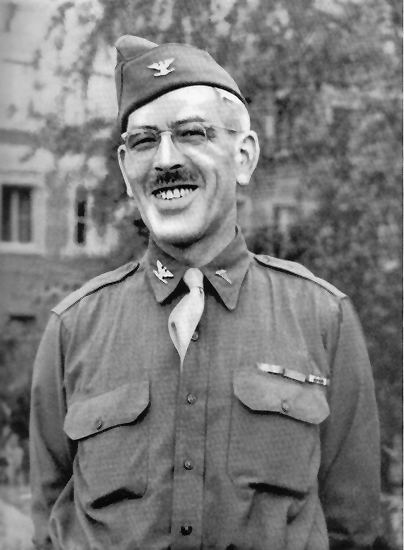
Photograph showing Colonel Homer P. MacNamara, Commanding Officer of the 96th Evacuation Hospital. It is believed that this photograph was taken late 1944 or early 1945.
The unit then embarked upon an extensive training program that took them from Camp Shelby, Mississippi, to Camp Polk, Leesville, Louisiana (Armored Division Camp –ed) and finally to the Kisatchie National Forest, also in Louisiana. In this cool and refreshing spot, the organization went through the rigors of rain – wind – heat – snakes – flies – mosquitoes and woodticks. On 7 July 1943, while the unit was encamped in the National Forest, field veteran Lt. Colonel Homer P. MacNamara took command of the unit and relieved Lt. Colonel J. Helfrich. During the maneuvers, the unit cared for about 6,000 patients, about 50% of whom were returned to duty.
On 16 October, the 96th left De Ridder, Louisiana, once again bound for Camp Shelby, Mississippi. During the preceding months, changes were made to the unit’s organization and staff in order to bring it up to full T/O strength (as per T/O 8-580 dated 23 April 1943, aggregate personnel consisted of 47 Officers, 53 Nurses, 1 Warrant Officer, 1 Hospital Dietitian, and 308 Enlisted Men –ed). January 1944 found the unit ready to undergo final tests, see “must” movies, and attend lectures. Showdown inspections were held frequently and roll calls implemented during formations. Immunization shots, personnel changes and adaptations, and issue of additional equipment were completed to meet the necessary requirements for overseas duty. Nurses assigned to the unit finally left Camp Shelby on 25 January 1944, reaching Camp Kilmer, Stelton, New Jersey (Staging Area for New York Port of Embarkation –ed) five days later. The remaining balance of the unit arrived at Camp Kilmer on 2 February 1944.
Locations in the Zone of Interior – 96th Evacuation Hospital
Camp Shelby, Hattiesburg, Mississippi, ZI – 14 August 1942 > 25 January 1944 (basic station)
Camp Kilmer, Stelton, New Jersey, ZI – 2 February 1944 > 20 February 1944

The 96th Evacuation Hospital traveled to Louisiana in June-July 1943 for maneuvers. The organization would set up in daylight as well as in total darkness, in woods, near swamps, and in rain, wind, heat, snakes, and a myriad of insects. The picture shows the men having delicious ham dinners and lots of ice cream but also drinking hot cokes and looking for water and shade underneath a hot Dixie sun …
Overseas Movement
Marching orders were received, and the staff prepared to leave Camp Kilmer on 12 February 1944. The sailing date was however canceled and the Hospital finally departed Camp Kilmer by train, destined for the New York P/E, where it boarded the troopship “Aquitania” (carrying approximately 12,000 replacements –ed). Later that evening, 21 February 1944, the ship set sail alone with destination overseas, i.e. Port Gourock, Scotland. After an uneventful trip across the Atlantic, the weather was mild and no bad storms were encountered, she reached her final destination arriving in Scotland, United Kingdom, on 28 February 1944, and dropping anchor that same evening.
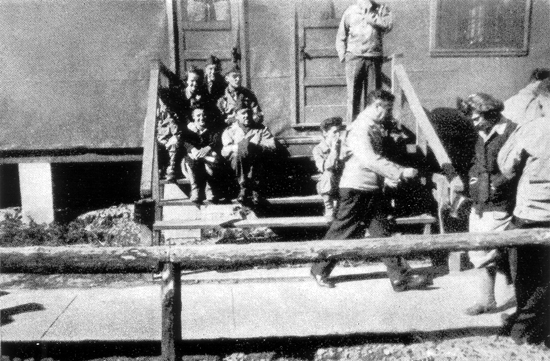
The unit’s final days at Camp Shelby, Hattiesburg, Mississippi were spent mainly in classroom instructions and studies. The photograph above shows both Enlisted personnel and members of the Nursing Staff from the 96th Evacuation Hospital. Note how the male personnel wear the M1941 Field OD Jacket and woolen flannel “mustard” trousers.
Arrival and Operations in the ETO
From here, the unit moved down through Glasgow, Scotland and further on to England via train experiencing their first actual taste of K-rations, although later, when stopping on the way around 2100 hours, the unit members received coffee and doughnuts from some British Red Cross ladies. Before noon, 1 March 1944, the 96th Evac arrived at Crewkerne, Somerset, England, where the necessary arrangements were made with the 97th Evacuation Hospital for the unit’s stay. Officers were scattered in several buildings in town, Nurses quarters were located in what had previously been a hotel, and Enlisted Men were billeted in three different buildings and locations around town. Training exercises were scheduled to start including inside classes, field demonstrations, and road marches. During this period, the personnel visited other units gaining much experience and receiving many helpful suggestions and good ideas. A ‘dry run” through the hospital proper was to follow later. While leaves and furloughs were taken care of, many members of the command were sent to specialized schools to acquire skills and learn new techniques. Preparations were also made for the forthcoming move to France; vehicles were marked and waterproofed, and hospital tentage adorned with Geneva Convention Red Crosses. The unit received “5 Day Orders” on 30 April 1944, and all the necessary preparation was made for a quick move, which however would take quite some time, before it would actually make the channel crossing to the continent …

Members of the Army Nurse Corps pertaining to the 96th Evacuation Hospital fall into formation in the town square in Crewkerne, Somerset, England. Behind the Nurses in the foreground can be seen members of the unit’s enlisted personnel (wearing 4-pocket “Class A” uniforms).
Stations in the United Kingdom – 96th Evacuation Hospital
Crewkerne, Somerset, England – 1 March 1944 > 12 June 1944
Seaton Barracks, Plymouth, Devon, England – 12 June 1944 > 15 June 1944

Peter Heos (right) with two other unidentified members of the 96th Evacuation Hospital pose in front of the sign at the entrance to their hospital during the unit’s pre-invasion maneuvers in Crewkerne, Somerset, England.
France
Orders were received at 1500 hours, 11 June 1944 instructing that all vehicles and personnel were to be moved to the Port of Plymouth under command of the 96th Evac Hosp’s Executive Officer, Lt. Colonel Philip Mulherin (who later joined the 91st Gen Hosp –ed). After their arrival on 12 June, being temporarily quartered in Seaton Barracks, Plymouth, the unit and its equipment remained there until 15 June, when personnel and supplies were taken to the embarkation area, and “Mae West” life preservers issued. The troop ship “Javelin” set sail at 1900 hrs carrying all necessary personnel and equipment to establish a functioning Evacuation Hospital upon debarkation, including 1,000 Infantry replacements. The unit landed on Utah Beach at approximately 1500 hrs on 16 June 1944, disembarking from LCTs and being met behind the sand dunes by Colonel Paul Hayes (VII Corps, Utah Assault Force Surgeon).
From Utah Beach, the unit traveled by truck to the 128th Evacuation Hospital located at Ste-Marie-du-Mont. At 1800 hrs on 18 June the unit relocated to fields west of Ste-Mère-Eglise, and established itself as a functioning hospital the next day. As of 0600 hrs 19 June 1944, it was now ready to receive its first patients in France. It is believed that the 96th was the fifth US Army Evacuation Hospital to land in France, and the fifth to open and start operations on the continent. During its time at Ste-Mère-Eglise, the Hospital received 4,000 patients, executed 2,700 surgical operations and 1,800 informal transfers. While in Ste-Mère-Eglise, the functioning Hospital was visited by high-ranking Officers, including Lt. General Omar N. Bradley and Lt. General George S. Patton, Jr. Maj. General Albert W. Kenner, MC (Chief Medical Officer, SHAEF) visited the installations twice.
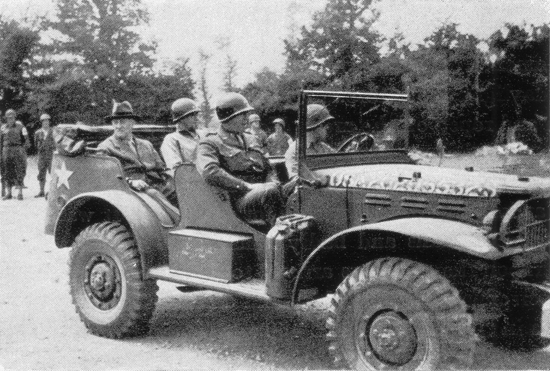
US Secretary of War Henry Stimson visits the 96th Evacuation Hospital during its stay in Ste-Mère-Eglise. Also shown in the WC57 Dodge 3/4-ton 4X4 Command Truck are Lt. Generals Omar N. Bradley and George S. Patton, Jr.
On 24 July, the 96th Evac Hosp departed at 0745 hrs for La Forêt. During the fifty-mile journey, the unit was reinforced with Nurses and Auxiliary Surgical Teams from the 41st Evacuation Hospital. The hospital complex that the unit had established came under attack from enemy aircraft on 30 July, and bombs were dropped on Nurses’ quarters thankfully injuring no one. The unit left the area a day later before sunlight for a new location in the vicinity of Marigny. By noon of the same day the Hospital had reopened and was ready to receive its first patient by 1800 hrs. While in this area, the 96th treated 1,163 patients and performed 813 surgical procedures. The organization closed for operations on 7 August, with the last remaining patients being transferred on 11 August 1944.
Locations in France – 96th Evacuation Hospital
Ste-Marie-du-Mont, France – 16 June 1944 > 17 June 1944
Ste-Mère-Eglise, France – 18 June 1944 > 24 July 1944
La Forêt, France – 24 July 1944 > 31 July 1944
Marigny, France – 31 July 1944 > 14 August 1944
Villedieu-les-Poêles, France – 14 August 1944 > 21 August 1944
Senonches, France – 22 August 1944 > 27 September 1944
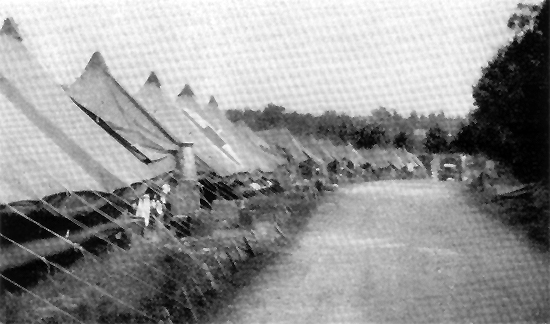
Photograph showing the lines of Hospital Ward Tents established by the 96th Evacuation Hospital on the western outskirts of Ste-Mère-Eglise. The photograph was taken on 22 June 1944, just three days after the unit officially opened to patients.
A Movement Order was received at 0400 hrs on 14 August 1944, and the unit subsequently departed the area by 1000 hrs for a thirty-mile trip to Bois Yvonne, near Villedieu-les-Poêles, France. At 2000 hrs on the same date the 96th Evacuation Hospital was ready again to receive patients. During its time in this area, the unit only treated 270 patients, and orders were received for the unit to be on the move again on 21 August (having been delayed a number of times previously, due to logistic issues, no trucks available -ed). The unit then embarked upon a 180-mile journey across France to the Senonches concentration area where the First United States Army was assembling hospitals and other medical units. The unit set up its hospital in this area, and was ready to receive a new wave of patients by 1100 hrs on 23 August. It remained in this location until 15 September, having handled approximately 1,100 patients and only 625 surgical cases.
The unit’s time in Senonches was also used as a much needed R&R time for personnel. Passes were distributed for visits to Chartres, as well as to local places of interest, and Lt. Colonel H. P. MacNamara organized a dinner party for the Officers in a local hotel. Enlisted personnel also staged their own party, inviting patients and locals.
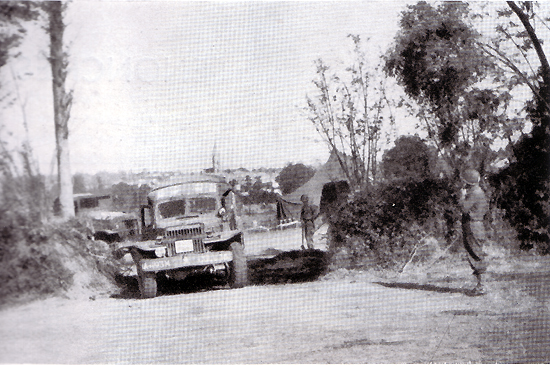
Photograph showing a WC54 Ambulance leaving the hospital facility of the 96th at Marigny, France. Of special interest is some of the Ambulance’s livery; two oversized Red Cross symbols on the roof of the driver’s cab are certainly not standard Army Regulation.
Belgium
On 28 September 1944, the 96th Evacuation Hospital crossed into Belgium, and passing through Dinant and Liège, finally reached Eupen where members bivouacked for the night in a building occupied by the 2d Evacuation Hospital. By this time, the unit had covered 400 miles in just under 48 hours. The two following days were spent locating suitable areas for bivouacking near to Eupen, Belgium. Suitable buildings were located in Montzen, and everyone moved in by 2 October 1944. During its time in Montzen, the 96th sent Nurses to lend a hand to the nearby 2d Evacuation Hospital (Eupen) and also delegated a maxillo-facial team to the 91st Evacuation Hospital in Holland. During bivouac, some of the personnel visited other cities of Belgium such as Verviers and Liège, soon to go down in memory as a real “Buzz-Bomb Alley”.
Montzen (north of Eupen, Belgium –ed) proved largely a stop-off point for the unit, and it received orders that the next location was to be in Germany. An advance party of Officers and some EM left on 11 November to clean and prepare buildings in the vicinity of Aachen, Germany. From 11 to 21 November 1944, troops and materiel were sent forward daily. The final lot of personnel and equipment arrived in Germany (near Brand, Germany –ed) on 21 November, and the Hospital was able to open up for “business” at 0800 hrs the following day. This made the unit the first Evacuation Hospital to officially enter Germany. December of 1944 was spent treating casualties of the Battle of the Bulge, and enjoying Christmas with the American Red Cross representatives. Although much nearer the front lines, the organization felt much safer than in Montzen.

Photograph showing the rather extravagant billets (left) and HQ (right) in which the 96th Evacuation Hospital found refuge during its stay in Montzen, Belgium.
Locations in Belgium – 96th Evacuation Hospital
Eupen, Belgium – 29 September 1944 > 2 October 1944
Montzen, Belgium – 2 October 1944 > 21 November 1944
(Brand, Germany – 21 November 1944 > 30 December 1944)
Velm, Belgium – 30 December 1944 > 14 January 1945
Spa, Belgium – 14 January 1945 > 15 February 1945
Dolhain, Belgium – 15 February 1945 > 27 February 1945
Orders were received on 27 December for the unit to move back to Belgium. The 96th Evac Hosp left their barracks near Brand, Germany destined for Velm, Belgium (northwest of Brussels, Belgium -ed). The end of 1944 was spent mainly trying to make personnel comfortable in the cold cramped conditions of a Belgian Convent School. By mid January 1945, the Hospital received orders to relocate to Spa, also in Belgium, where it was intended to help treat further battle casualties from the Bulge fighting.

The 96th Evacuation Hospital when set up in Brand, near Aachen, Germany, in November 1944 (where the organization spent Christmas).
The unit arrived and established a functioning hospital inside what had once been Belgian Cavalry Barracks, and through the use of “sibley” (sheet-iron) stoves, patients and personnel were made as warm and comfortable as possible. Members of the unit recollect being extremely busy during their stay in Spa, with the majority of patients being either “frostbite” or “trenchfoot” cases. It was later realized that the 96th Evacuation Hospital had been the first Evacuation Hospital in the Bulge, and that during the first week of operations, they were within 8 miles of the front line. During this time, the 96th was established in unsanitary riding halls, cavalry barns and operating facilities in empty stables.
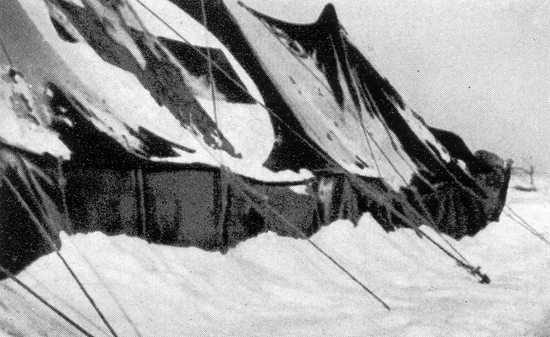
Snowed-in Hospital Ward Tent of the 96th Evacuation Hospital during their time in Velm, Belgium, end December 1944.
On 15 February 1945, the 96th was garrisoned at Dolhain, Belgium, with Headquarters and billets for the CO and Enlisted personnel located in a Church and School building in town. Nurses and Officers were billeted in private homes, and this was the first time that the unit had encountered the luxuries which the private homes provided. Unfortunately, the stay in Dolhain was relatively short, lasting only thirteen days, until the unit was ordered to relocate to a former girls’ school in Eschweiler, Germany (slightly northeast of Aachen –ed).
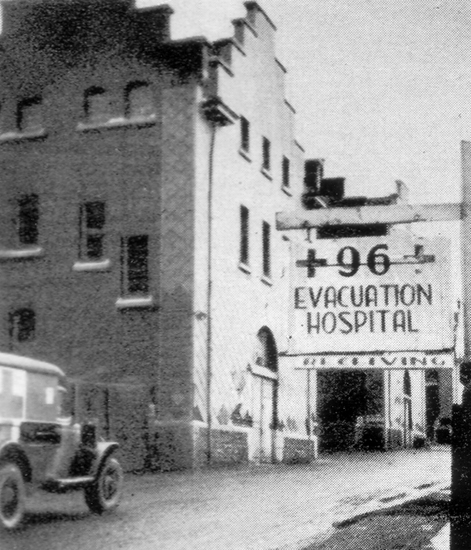
Photograph illustrating the Belgian Cavalry Barracks in which the 96th Evacuation Hospital was billeted while in Spa, Belgium. The Ambulance is bringing in wounded troops from the Battle of the Bulge.
Germany
The first patient in Eschweiler was received early on 1 March 1945, and within 24 hours of operation the Hospital already had a backlog of more than 150 surgical cases. The unit spent its final days at Eschweiler, Germany, where for the following 10 days it continued to offer surgical and medical care to hundreds of troops. The 96th finally closed as an Evacuation Hospital at 1200 hrs on 11 March 1945.
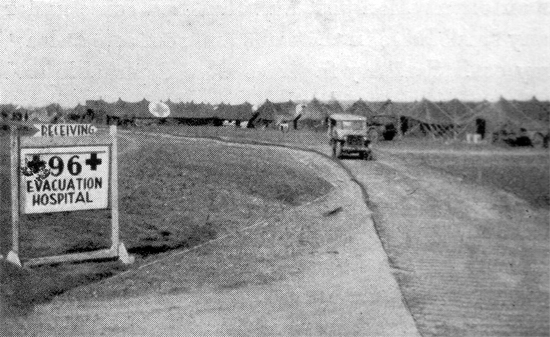
Photograph showing the newly opened tented Hospital located in the fields east of Dünstekoven, Germany. The photograph was taken at approximately 1500 hrs on 25 March, only 3 hours following the Hospital’s opening to patients and surgical cases.
It however reopened the next day, 12 March, at 0800 hrs as a “Provisional Convalescent Hospital”. Between 20 and 24 March, the unit made a leisurely and very gradual move to Dünstekoven, Germany situated on the west bank of the River Rhine. The unit set up under canvas and was glad to get back into the spring sunshine and fresh air, opening at 1200 hrs on 25 March 1945. The unit was not especially busy, however, and so stretcher bearers were deemed unnecessary. This decision resulted in seeing high-grade Officers such as the Chief of Surgery carrying litters!
On 30 March 1945, the provisional unit prepared for its first aerial movement, which would be the first air move of an Army Evacuation Hospital in Europe. As a result numerous correspondents and Signal Corps photographers arrived in abundance for the planes’ arrivals. The aircraft took sufficient personnel and equipment to act as a guard on the forward airfield and on the following day the remaining staff and equipment were moved forward to Gießen, Germany. On the day of arrival at Gießen (Easter Sunday, 1 April 1945) the unit opened a tented Hospital at 2400 hours. Billets were in a German Weather Bureau building for the Nurses, and in former German Cavalry Barracks for the Officers and Enlisted personnel. During its time in this area the organization mostly handled DPs and PWs. The Supply and Evacuation Airstrip was designated Y-84 and was built by Aviation Engineers of the IX Engineer Command.
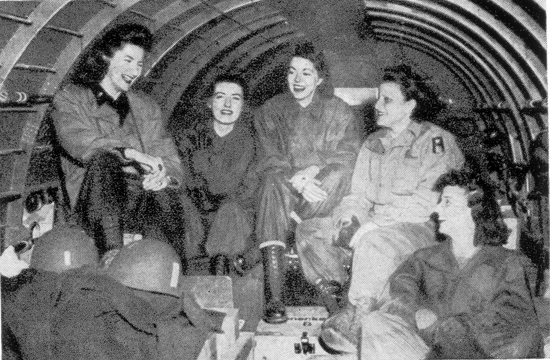
Photograph showing five members of the Nursing staff of the 96th Evacuation Hospital in flight with equipment necessary to establish the Hospital upon landing; final destination is Gießen, Germany. Picture taken 30 March 1945.
The Hospital was once again on the move 15 days later. Personnel and equipment were transported by air to various locations and re-assembled at their final destination of Nietleben, slightly west of Halle, Germany, on the morning of 17 April 1945. At 1200 hrs, two days later the Hospital was once again open and ready to receive patients. For this period, it operated out of abandoned Luftwaffe buildings, while billets were assigned in old German Barrack rooms. The grounds around this Luftwaffe Technical Training School (Luftnachrichtenschule) looked like a park, being surrounded with trees, shrubs, flowers and grass. During the 18 days of operation in this area, the provisional Hospital handled many cases of transient RAMPs, although other casualties were also treated. The change-over from direct support to combat forces to the care of non-combatants, such as Displaced Persons, and enemy PWs, started about 1 May 1945.
Locations in Germany – 96th Evacuation Hospital
Eschweiler, Germany – 27 February 1945 > 24 March 1945
Dünstekoven, Germany – 25 March 1945 > 2 April 1945
Gießen, Germany – 2 April 1945 > 17 April 1945
Halle, Germany – 17 April 1945 > ?? October 1945
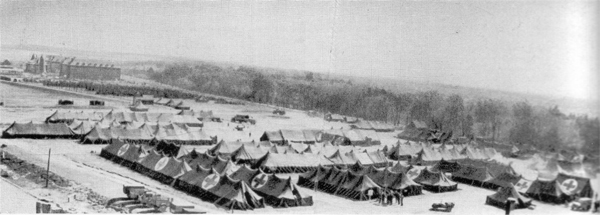
A bird’s eye view of the large tented installations of the 96th Evacuation Hospital established at Gießen, Germany. A range of tentage can be seen including Hospital Ward Tents, Pyramidal and Large Wall Tents. The photograph is believed to have been taken on 3 April 1945.
“The 96th”
(Poem by Pfc. George DeHeck; Ward 5 Personnel, 96th Evacuation Hospital)
In rain, in heat, in cold and snow
The 96th was on the go.
It set up for a week or two
And then our Armies pushed anew.
We’d pack our things and move again
To keep up with our fighting men.
The wounded got the best of care
For everybody did his share.
And now that victory’s here at last
The conflict is a thing of the past.
Some men are Pacific bound
And others here to stay;
But 96’s voice resound —
“Oh, for the U.S.A.!”
On 9 May, 1945 while the unit was located and operational in the vicinity of Halle, Germany, V-E Day was announced, and the Hospital continued to operate for a number of days following the announcement of the end of the War in Europe. Following the V-E Day declaration, the unit traveled through Germany, and back into Belgium. In October 1945, part of the 96th Evacuation Hospital personnel was transferred to the 53d Field Hospital (recently attached to the 68th Medical Group –ed), while the majority returned to the United States.
The majority of the personnel left Braunfels, Germany on 8 November, and arrived at Metz, France the following day. The personnel were then taken to the Calas Staging Area in southern France for preparation of overseas movement to the Zone of Interior. The medical personnel left the port of Marseille on 19 November, and were finally back in the United States by 16 December 1945, where they were transferred to Camp Patrick Henry, Oriana, Virginia, at 0616 hrs, for demobilization.
Number of Patients Treated by the 96th Evacuation Hospital
Surgical Patients – 16,148
Medical Patients – 8,376
X-Ray Patients – 12,614
OR Patients – 10,499
Deaths – 300
The 96th Evacuation Hospital handled 22% of all First United States Army casualties in WW2
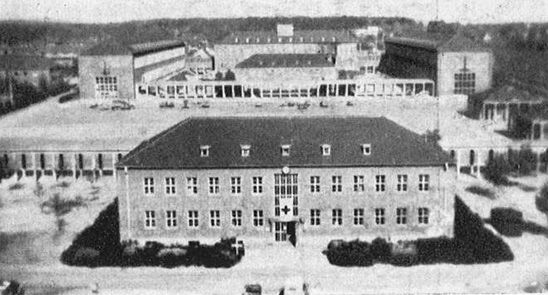
Illustration showing the Headquarters Building of the 96th Evacuation Hospital in Halle, Germany. The building itself was part of the complex housing the former German Air Force Luftnachrichtenschule.
The 96th Evacuation Hospital was FIFTH to arrive in France
The 96th Evacuation Hospital was FIRST to enter Germany
The 96th Evacuation Hospital was FIRST to move by air
Unit Roster
The following is a roster of members and ranks as of July, 1945:
| Staff of Officers | ||
|---|---|---|
| SURNAME | FORENAME(S) | RANK |
| Arons | Abraham | Capt. |
| Beitman | Max, H. | Capt. |
| Brousseau | Albert, A. | Capt. |
| Brownson | Kneale, N. | Maj. |
| Burns | Gordon, T. | Capt. |
| Downey | Frank, S. | Capt. |
| Drum | Borden, C. | Maj. |
| Emery Jr. | Clarence | Maj. |
| Farrington | Charles, L. | Maj. |
| Griffiths | James, A. | Maj. |
| Leech | Charles, H. | Maj. |
| Rustin Jr. | Arthur, L. | 1st Lt. |
| Hall | Woodrow, W. | W.O. |
| Heligman | Harold | Capt. |
| Kelley | Calvert, L. | Capt. (Chaplain) |
| Kerr | Woodard, W. | Capt. |
| Krull | Bernard, A. | Capt. |
| Larsen | Stanley, S. | 1st Lt. |
| Lieberman | David | Capt. |
| Lutz | Eugene, E. | Capt. |
| MacNamara | Homer, P. | Maj. |
| Mueller | John, J. | Capt. |
| Neff | Garnet | Capt. |
| Oatman | Jack, G. | Maj. |
| Osterhagen | Harold, F. | Capt. |
| Peirce | Wilmot, W. | Capt. |
| Siegert | Rudolph, B. | Lt. Col. |
| Stevens | Robert, H. | Capt. |
| Stoops | Richard, B. | Capt. |
| Storch | Sidney | Capt. |
| Spedden | James, M. | 1st Lt. |
| Windram | Arthur | 1st Lt. |
| Zarinelli | Angelo, A. | 2d Lt. |
| Staff of Nurses | ||
| Gebhardt | Christine, M. | Capt. |
| Ahern | Bertha, J. | 1st Lt. |
| Brennan | Eillen, M. | 1st Lt. |
| Brown | Helen, B. | 1st Lt. |
| Budmirovich | Mildred, L. | 1st Lt. |
| Burns | Elizabeth, R. | 1st Lt. |
| Cable | Marjorie, G. | 1st Lt. |
| Christensen | Christine | 1st Lt. |
| Conant | Constance | 1st Lt. |
| Dougherty | Helen, M. | 1st Lt. |
| Etherington | Dorothy, E. | 1st Lt. |
| Farrell | Marjorie, E. | 1st Lt. |
| Giebelhaus | Doris, H. | 1st Lt. |
| Giroux | Garbrielle, N. | 1st Lt. |
| Haag | Margaret Ayer | 1st Lt. |
| Hargrove | Louise, M. | 1st Lt. |
| Helt | Adeline, A. | 1st Lt. |
| Husband | Jessie, W. | 1st Lt. |
| Jones | Lorene, V. | 1st Lt. |
| Kayes | Elizabeth, L. | 1st Lt. |
| King | Rose | 1st Lt. |
| Lizza | Philida, M. | 1st Lt. |
| Mack | Kathryn, F. | 1st Lt. |
| McMahon | Rheta, A. | 1st Lt. |
| Morris | Margarette, E. | 2d Lt. |
| Mullen | Doris | 1st Lt. |
| Miles | Joan | 1st Lt. |
| Oswaldt | Beatrice | 1st Lt. |
| Payne | Lillian, E. | 2d Lt. |
| Pulkinen | Hilma | 1st Lt. |
| Sullivan | Mary | 1st Lt. |
| Taylor | Zoe, M. | 1st Lt. |
| Toussaint | Lorraine, L. | 1st Lt. |
| Wells | Catherine, L. | 1st Lt. |
| Whitham | Hazel | 1st Lt. |
| Zoller | Klara, H. | 1st Lt. |
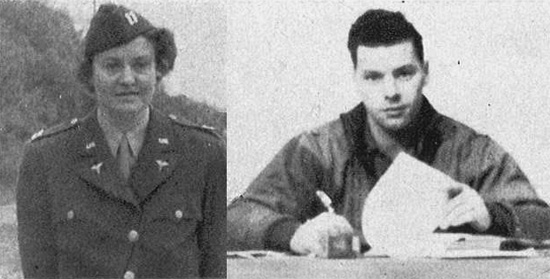
Chief Nurse, 96th Evacuation Hospital, Captain Christine M. Gebhardt, ANC + Executive Officer, 96th Evacuation Hospital, Captain Woodard W. Kerr, MC.
| A.R.C. Members and Hospital Dietitians | ||
|---|---|---|
| Szumowski | Michelle | Mrs. |
| Paboojian | Ruth | 1st Lt. |
| Lesko | Hermine, A. | Mrs. |
| Ganong | Alice, E. | 1st Lt. |
| Krone | Myrtle, M. | 1st Lt. |
| Metz | Marjorie | 2d Lt. |
| Kerr | Bertine, Clark | Mrs. |
| Cadwell | Maud, M. | 1st Lt. |
| Wolcott | Minnie | 1st Lt. |
| Smith | Delia, K. | Mrs. |
| Susskraut | Velzara | 2d Lt. |
| Huntington | Marie, R. | 1st Lt. |
| Hayde | Katherine | 2d Lt. |
| Kennedy | Madelaine | 2d Lt. |
| Godwin | Rena | 2d Lt. |
| Anderson | Frances | 2d Lt. |

Group view of 96th Evacuation Hospital Ward male and female personnel. Picture taken during the unit’s stay in Halle, Germany.
| Enlisted Personnel | ||
|---|---|---|
| Adkins | Leonard | – |
| Anders | Don | – |
| Anthony | John | – |
| Applewhite | Claude | – |
| Banwell | Carol | – |
| Barker | Lessel | – |
| Barrella | Jack | – |
| Bartholomew | Kenneth | – |
| Bashaw | Lawrence | – |
| Baughn | Johnnie | – |
| Bella | Oliver | – |
| Beyer | Kenneth | – |
| Broughton | Bernard | – |
| Bobinger | James | – |
| Burton | Wayne | – |
| Bushman | Chester | – |
| Cammarota | Joseph | – |
| Campbell | Neil | – |
| Cantley | Forest | – |
| Carino | Gebriel | – |
| Carpenter | Robert | – |
| Case | John | – |
| Chaix | Louis | – |
| Ciancimino | Nino | – |
| Clarkson | Hubert | – |
| Cloke | George | – |
| Cohen | Jacob | – |
| Collins | Arthur | – |
| Connor | Paul | – |
| Compropst | Clarence | – |
| Conway | John | – |
| Cook Jr. | Walter | – |
| Coombes | Adelbert | – |
| Corbalis | Luke | – |
| Cox | Elmer | – |
| Crouch | Charles | – |
| Culler | Robert | – |
| D’Amico | Joseph | – |
| Davis | Francis | – |
| De Heck Jr. | George | – |
| De Rosa | Anthony | – |
| Di Cerce | Daniel | – |
| Di Domenico | John | – |
| Dotson | Loyd | – |
| Diere | Harold | – |
| Durbin | James | – |
| Edmond | Wallace | – |
| Eldridge | William | – |
| Else | James | – |
| Embesi | Anthony | – |
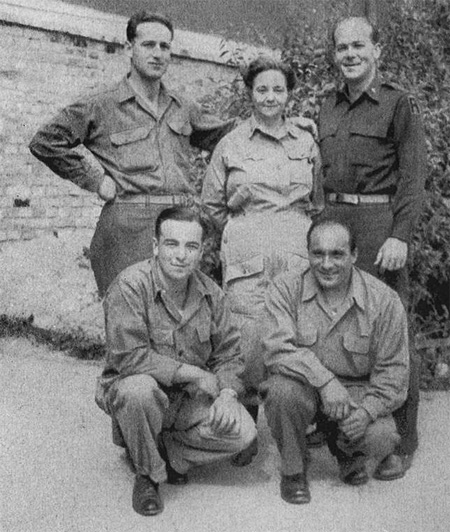
Medical personnel of Ward 4, 96th Evacuation Hospital. Front row (L to R) Tec 5 Joseph Powell, Pfc Isaac Ortega; back row (L to R) Tec 5 Robert Vogel, 1st Lt Catherine M. Wells, Major Charles L. Farrington.
| Faroni | Telio | – |
| Feuerstein | Henry | – |
| Foland | Millard | – |
| Foster | Ike | – |
| Fox | Otto | – |
| Gaffney | Dennis | – |
| Garrity | John | – |
| Gaston | George | – |
| Gering Jr. | Gustave | – |
| Gilmore | James | – |
| Glorioso Jr. | Charles | – |
| Gorski | Walter | – |
| Grantham | Reid | – |
| Graziano | Joseph | – |
| Halpin | John | – |
| Hancock | Harold | – |
| Hardies | Robert | – |
| Harris | Earl | – |
| Hassler | Benny | – |
| Heminover | Robert | – |
| Heos | Peter | – |
| Hess | Richard | – |
| Hobson | Harold | – |
| Holton | Alfred | – |
| Huff | Robert | – |
| Jackson | James | – |
| Johnston | Frank | – |
| Jordan | Herl | – |
| Kamp | Leo | – |
| Kaplan | Aaron | – |
| Kaselonis | Joseph | – |
| Kirkpatrick | Glenn | – |
| Kent | Willie | – |
| Kober | Victor | – |
| Koepke | La Verne | – |
| Koster | Elmer | – |
| Kulson | Albert | – |
| Lankester | Leslie | – |
| Laurenzo | Joseph | – |
| Lavoie | Arthur | – |
| Lawrence | Robert | – |
| Lee | Travis | – |
| Lightfoot | Gordon | – |
| Lipovich | Jennings | – |
| Lundy | Weedon | – |
| Maerz | Carroll | – |
| Manning | R. | – |

Copy of the Menu which was handed to every member of the 96th Evac in preparation for the Christmas Dinner to be held in Germany on 25 December 1944.
| Matturro | Domenick | – |
| Mattson | John | – |
| Mazur | Bernard | – |
| McBain Jr. | John | – |
| McCann | Victor | – |
| Medley | James | – |
| Medvicky | Michael | – |
| Metz | William | – |
| Meyers | Merlyn | – |
| Millett | John | – |
| Miller | Walter | – |
| Minella | Joseph | – |
| Mollenhauer | Theodore | – |
| Monahan | Thomas | – |
| Mongelli | Leonard | – |
| Mongelli | Paul | – |
| Morgan | Willie | – |
| Monroe | Otus | – |
| Mullins | Chester | – |
| Muller | Robert | – |
| Murphy | David | – |
| Nash | Hugh | – |
| Nickerson | Norman | – |
| Odom | Reuben | – |
| O’Kelley | Lowell | – |
| Onderdonk | Paul | – |
| Ortega | Isaac | – |
| Owen | Jim | – |
| Palmer | Aubrey | – |
| Passerelli | Anthony | – |
| Pasquarelli | Louis | – |
| Pate | Fred | – |
| Percie | Ernest | – |
| Perillo | Joseph | – |
| Pesello | John | – |
| Petratos | Elias | – |
| Petula | Andrew | – |
| Pierce | Ralph | – |
| Pitcher | William | – |
| Powell | Joseph | – |
| Powers | Raymond | – |
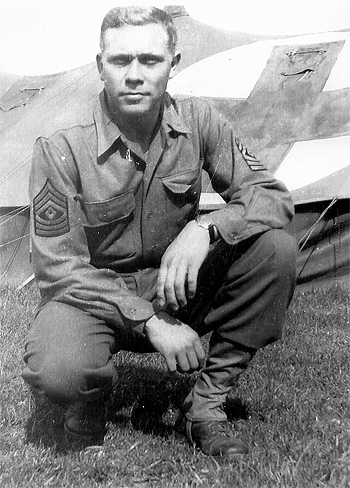
Picture of First Sergeant Nathaniel L. Prather, ASN-34351921, in front of one of the ward tents.
| Prather | Nathaniel | – |
| Prince | George | – |
| Prudden | John | – |
| Raketich | Michael | – |
| Ramsey | Ben | – |
| Richardson | James | – |
| Rickert | Robert | – |
| Rikard | Robert | – |
| Roberson | Clyde | – |
| Robertson | James | – |
| Roland | Robert | – |
| Rosenfeld | Richard | – |
| Roth | Marvin | – |
| Rutkunas | Joseph | – |
| Saffarrans | Daniel | – |
| Sampson | Reedy | – |
| Schmier | Herman | – |
| Schwartz | Morris | – |
| Sciarrotta | Frank | – |
| Sepp | Claude | – |
| Sherer | Alfred | – |
| Silvey | Albert | – |
| Skinner | Fred | – |
| Skold | Gerard | – |
| Smith | Wilbur | – |
| Smith | Luther, P. | – |
| Speights | Oliver | – |
| Spielman | Robert | – |
| Spitz | Lester, J. | – |
| Stehlin | Robert | – |
| Stepina | Joseph | – |
| Storino | Joseph | – |
| Soscia | Louis | – |
| Sweeney | Albert | – |
| Szastack, Sr. | Frank | – |
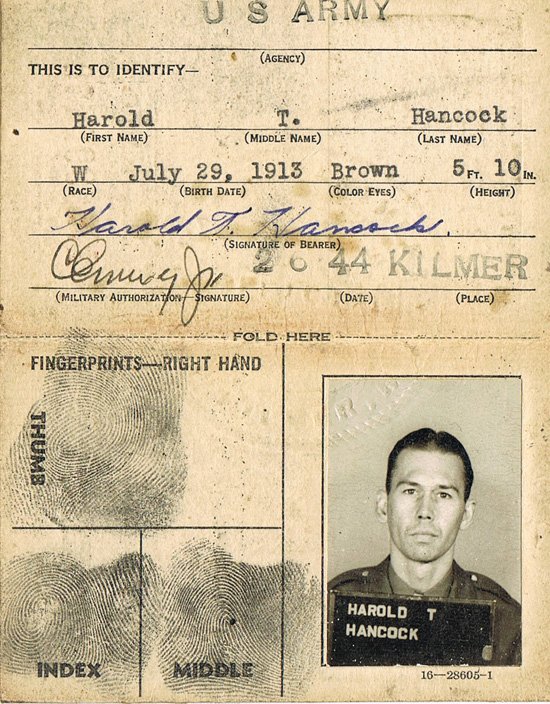
Medical ID Card (1st pattern, folded leather-effect) of T/4 Harold T. Hancock (ASN:32666624) who served with the 96th Evacuation Hospital.
| Tennissen | Anthony | – |
| Termini | James | – |
| Thibodeau | Arthur | – |
| Tiner | Edward | – |
| Thomas | Hollis, A. | – |
| Thomas | Michael | – |
| Thompson | Milton | – |
| Traudt | Randolph | – |
| Turpin | Renee | – |
| Vand Horn, Jr. | James | – |
| Veit | Albert | – |
| Versocki | Stanley | – |
| Vogel | Robert | – |
| Walker | James | – |
| Wells | Elmer | – |
| Wesley | George | – |
| Whitlock | Guy | – |
| Wilbanks | Art | – |
| Wilhite | Henry | – |
| Williams | Alan | – |
| Wing | Hew | – |
| Witkowski | Joseph | – |
| Wroblewski | Eugene | – |
| Yawn | Willard | – |
| Yusi | Joseph | – |
| Ziewacz | John | – |
The images used in this Article were kindly donated to the WW2 US Medical Research Centre by Linda Hancock Houk, daughter of T/4 Harold T. Hancock (ASN:32666624). Additional data and illustrations were further provided by Ricky Smith, son of Sgt Luther P. Smith (ASN:34477258) who served with the 96th Evacuation Hospital in the ETO. The MRC Staff also wish to acknowledge the kind assistance of cousin Jo Berry. More thanks should also go to Bill Prather son of First Sergeant Nathaniel L. Prather (ASN:34351921),who also served with the 96th, for sharing some photos and data.Sincere thanks to all.
